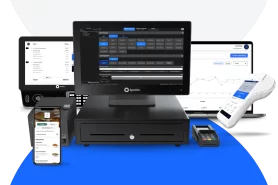Call Today For a Free Demo: 303-309-1218
Email: info@smarterpos.net
Retail POS Systems
What Is A Retail POS System?
A retail POS system is the terminal or area where all the transactions take place. At the Point of sale, the employee or merchant calculates the amount the customers owe to the retail store. In the next step, the total amount prints on a paper receipt (invoice). Lastly, the customer makes the payment at the POS terminal, through either a card or cash.
Hardware for Retail POS system
Conventional POS systems at Retail stores have basic electronic devices for every POS setup. These devices include the cash register, cash drawer, bar-code scanner, receipt printer, and credit card terminal. On the other hand, a modern POS system at a retail store contains more peripheral devices than the old one. Some of which include,
- Touch screens/iPads/tablets
- Customer Pole Display
- Advanced scanner/ portable barcode scanner
- Signature capture device
- Receipt printer
- Back office server
- Internet device
- Server that is connected to all the terminals
Today, technology surrounds people to the extent where they now have digital wallets. Therefore, all the retail stores should have a digital account where customers can transfer their payment through their digital wallets.
What was once a simple retail POS system with a few hardware components is now a complex retail POS system with variety of electronic devices.
Software Features for Retail POS System
Most retail stores have a similar point of sale system, unless a particular retail store has completely different policies for customers, sales, and employees. In such cases, professional POS companies have to design and install custom softwares on the POS system.
Following is a list of features that every basic Retail POS system software should have:
- Employee management
- Inventory/ stock management
- Third-party software merge
- Mobility
- Online management
- Scalability
- Credit card processing
- Reporting tools
- Back-up and security
- Virus -free operations
- Building sale records
Smart Ways to Set Up a POS System at a Retail Store
Purchase a POS system that starts small but grows faster with time. For example, if you are on a budget, opt for POS software with only the features that meet your existing needs. In the next step, run the software on an old PC. Also, keep a cash drawer and a receipt printer. This way you save your initial investments and grow your business. Later, you can invest further into the system and add more peripheral devices and upgrade your software as well.
Place an easy order for your retail POS system software. There are two main reasons for this. First, the service provider will take less time to program it for you. Secondly, simple functions won’t require a training program for the employees working at the retail store. This way, retailers save a lot of unwanted investment, and time that a training program might can take.
The most important thing that your retail POS system should mainly focus on is inventory management. All POS systems look out for inventory, but a retail POS system needs it every second of the day. Also, check if the retail POS system, which you plan to purchase, frequently assesses and reports inventory state.
Bottom Line
Being a retailer already requires extensive research for products at the store. Smart POS has your back by providing you the best POS system for your business, along with professional installation & support.
Call today:
SMART POS
Svend Bramsoe
303-309-1218

